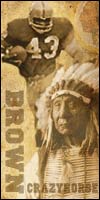http://www.footballoutsiders.com/nfl-dr ... ecast-2012
Lewin Career Forecast 2012
by Aaron Schatz
Six years ago, Football Outsiders unveiled the college quarterback projection system known as the Lewin Career Forecast. Originally, the LCF projected the success of first- and second-round quarterbacks using just college games started and college completion percentage. Going back -- including when looking at quarterbacks from the years before the data set used to create it -- it had a strong record. After 2006, the record was not so strong. So last year, we debuted an updated version of the forecast, LCF v2.0.
The new version of the Lewin Career Forecast is built to apply only to quarterbacks chosen in the first three rounds of the draft. After that, quarterback success and failure becomes too difficult to predict. Part of the concept of the system is that scouts will do a good enough job identifying "system quarterbacks" so that those quarterbacks whose college stats are much better than their pro potential will naturally fall to the third day of the draft.
There are seven variables involved in LCF v2.0:
Career college games started, with a minimum of 20 and a maximum of 48.
Career completion rate; however, this is now a logrithmic variable. As a quarterback's completion percentage goes down, the penalty for low completion percentage gets gradually larger. As a result, the bonus for exceedingly accurate quarterbacks such as Tim Couch and Brian Brohm is smaller than the penalty for inaccurate quarterbacks such as Kyle Boller and Tarvaris Jackson.
Difference between the quarterback's BMI and 28.0. This creates a small penalty for quarterbacks who don't exactly conform to the "ideal quarterback size."
For quarterbacks who come out as seniors, the difference in NCAA passer rating between their junior and senior seasons. (For quarterbacks who come out as juniors or redshirt sophomores, this variable is always 5.0, which is the average increase for the seniors in our data set.)
A binary variable that penalizes quarterbacks who don't play for a team in a BCS-qualifying conference.
Run-pass ratio in the quarterback's final college season, with a maximum of 0.5.
Total rushing yards in the quarterback's final college season, with a minimum of 0 and a maximum of 600.
These last two variables work together to penalize both quarterbacks who scramble too often and quarterbacks who take a lot of sacks (since sacks are negative runs in college), while pocket quarterbacks who are successful when they do run get a bonus.
The biggest question about LCF continues to be the importance of games started. This is still the most important variable in the equation. As I explained in last year's article, any quarterback projection system based on past performance is going to highly value collegiate games started. From 1990 to 2005, it was far and away the most important variable in determining the success of highly-drafted quarterbacks. However, there are questions about whether the rise of the spread offense is leading to number of quarterbacks who come into the NFL with a lot of collegiate experience yet still unprepared for the NFL-style game. Other quarterbacks have come into the NFL with less experience and done very well. The best example of this would be Cam Newton, who seems like the kind of guy who is built to break this system. He started only one year of Division I ball and looked like a huge risk, then put together one of the best rookie quarterback seasons in NFL history. Aaron Rodgers is another player who was underrated by the system; given the success of Newton and Rodgers, perhaps we need to consider adding junior college experience to the variable for collegiate games started.
Newton demonstrates where the system can go wrong, while Andy Dalton demonstrates where the system can go right. Dalton was the highest-rated prospect in last year's draft according to LCF and while his numbers (and his potential) don't match Newton's, his rookie performance surprised a number of observers who felt his arm wasn't strong enough to be a good NFL starting quarterback.
It's important to understand that LCF is meant to be a tool used alongside the scouting reports, not instead of the scouting reports. What matters is not which quarterback is ahead of which other quarterback by 100 points. Instead, what's important is who has an overall good or bad projection. Scouts still come first and foremost, but this method is valuable as a crosscheck device and should be part of the conversation about quarterback draft prospects.
With that in mind, let's look at the projections for this year's quarterbacks. These numbers represent an estimate for passing DYAR in years 3-5 of a player's career. The top prospects will be above 1,200 DYAR, and you should avoid quarterbacks below zero. Let's start with the top two guys, two of the highest-rated quarterbacks in LCF history who will also be the first two picks in the 2012 NFL Draft.








